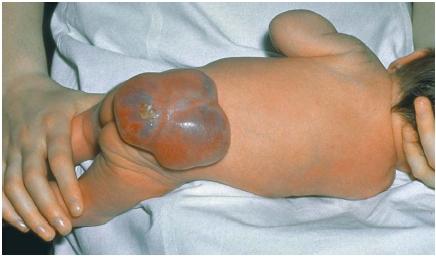Birth defects

Birth defects, or congenital defects, are abnormalities that are present at birth. They may be the result of genetic factors such as an inherited disease or a chromosomal abnormality. They may also be caused by environmental factors such as radiation, the mother's use of drugs or alcohol while pregnant, or bacterial or viral infections.
Birth defects can range from very minor, such as a birthmark, to a more serious condition that results in physical deformity or limits the lifespan of the child. Two to three percent of babies born in the United States have a major birth defect.
Chromosomal abnormalities
Some birth defects are caused by chromosomal abnormalities. Chromosomes are structures that are found in the nucleus of every human cell and that contain genes, the units of heredity. Genes are responsible for the physical traits and genetic makeup of an individual. A human fetus inherits 23 chromosomes from its mother and 23 chromosomes from its father, making a total of 46 chromosomes in 23 pairs.
The most common chromosomal abnormalities seen in humans involve an extra chromosome or a missing chromosome. Down syndrome (named for nineteenth-century English physician J. L. H. Down) is a birth disorder caused by the presence of an extra chromosome, so that a fetus with this condition has 47 chromosomes instead of 46. Down syndrome babies have distinctive facial features and other physical abnormalities, are mentally impaired, and often have heart defects. The likelihood of a baby being born with Down syndrome increases with the mother's age.
Inherited disorders
Birth defects that are inherited are caused by abnormal genes. Inherited disorders include sickle-cell anemia, cystic fibrosis, Tay-Sachs disease, and hemophilia.
Words to Know
Amniocentesis: Diagnostic technique in which a needle is inserted into the abdomen of a pregnant woman to remove amniotic fluid from the uterus for examination of fetal cells.
Chorionic villus sampling: Diagnostic technique in which a needle is inserted through the abdomen or a thin plastic tube is inserted through the cervix of a pregnant woman to obtain a sample of villi (from the membrane surrounding the fetus) for examination of cells.
Ultrasound: A diagnostic technique that uses sound waves to produce an image of the fetus within the uterus.
Sickle-cell anemia is a disease in which the blood cells are shaped like a sickle, or crescent, rather than like a concave circle. This abnormal shape impairs blood flow, resulting in life-threatening complications. Cystic fibrosis is a disease affecting the glands of the body that secrete substances such as sweat or saliva. It is characterized by an overproduction of mucus, leading to severe digestive and respiratory problems. Tay-Sachs disease is a rare, fatal disease caused by the lack of an enzyme (a chemical that speeds up a chemical reaction) that aids in the breakdown of certain fats in the brain. The resulting accumulation of fat deposits in brain cells usually leads to blindness and death by the age of three or four. Hemophilia is an inherited disorder in which failure of the blood to clot results in uncontrolled bleeding.
Physical birth defects
Physical birth defects may result from a combination of genetic and environmental factors that affect the normal development of the fetus. Common physical defects present at birth include clubfoot, in which one or both feet are deformed, and cleft lip and cleft palate, in which a split is present in the lip and roof of the mouth. Spina bifida is a malformation of the spine caused by incomplete closure of the vertebral column (backbone) during development.
Environmental factors
Environmental factors such as the mother's use of tobacco, alcohol, or drugs can affect fetal development and contribute to or cause birth defects. In addition, if the mother is exposed to or infected by an active virus, she may pass it to her child while it is in the womb or during delivery, resulting in complications such as mental retardation in the newborn.
Heavy use of alcohol during pregnancy can result in fetal alcohol syndrome. Babies with this condition typically have low birth weights, physical deformities of the face and head, and varying degrees of mental

retardation. They may also have behavioral problems and learning difficulties later in life.
Prenatal testing
Prenatal (before birth) testing can detect a number of congenital disorders. Ultrasound, which uses sound waves to produce an image of the fetus, can diagnose spina bifida and certain defects of the heart and other organs. Amniocentesis (pronounced am-nee-oh-sen-TEE-sus) and chorionic (pronounced kor-ee-AH-nik) villus sampling (CVS) are procedures used for detecting genetic disorders such as Down syndrome and sickle-cell anemia. Cells containing the fetus's genetic material are removed from the mother's uterus and tested for the presence of genetic abnormalities.
In recent years, techniques have been developed that allow doctors to operate on the fetus while it is still in the womb. Some congenital defects can be surgically corrected, and blood transfusions can be performed to treat certain conditions detected through prenatal testing.
Apgar Score
The Apgar score is the evaluation of a newborn baby's physical condition based on skin color, heart rate, response to stimulation, muscle tone, and respiratory effort. Each criteria is rated from zero to two with a total score of 10 indicating the best possible physical condition. The evaluation determines whether immediate emergency measures are needed. (A low score can indicate possible brain damage.) Because the score is closely related to an infant's life expectancy, it is used as a guideline to advise parents of their baby's chances of survival.
[ See also Birth ; Embryo and embryonic development ; Genetic disorders ]
im 17 years old and im interased about it
thank you for helping children